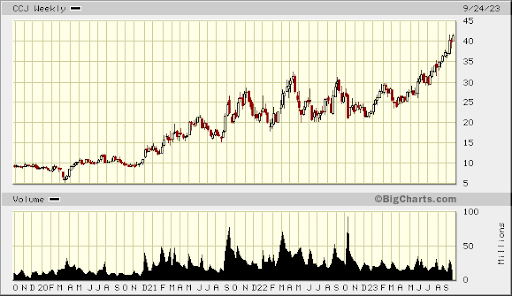A few years ago, I recommended uranium miner Cameco Corp. (NYSE: CCJ) in my Bull and Bust Report newsletter. The stock has done very well. It is up about 760% from its lows in 2020.

Nuclear energy is back in fashion as a source of green power. Oil prices are also up, with WTI above $90 and heading to $100. JPMorgan even came out with a $150 price prediction on the black stuff.
Coal miners are also up. Alliance Resource Partners (NASDAQ: ARLP) has climbed from $3.22 to $21.58, and it pays a 13% dividend. Despite the popular press declaring that the age of anthracite is over, coal still produces 20% of electricity in the United States and more than 60% of electricity in China and India, not to mention it's a necessary ingredient in steel production. Our analysts have traveled the world over, dedicated to finding the best and most profitable investments in the global energy markets. All you have to do to join our Energy and Capital investment community is sign up for the daily newsletter below.The Best Free Investment You’ll Ever Make
It should be noted that all of these energy sources are becoming more expensive even though the U.S. dollar has been gaining in strength over the past few years and also despite the fact that wind and solar have been heavily subsidized.
This raises the question if we are in or about to enter a new commodity supercycle.
A global commodities supercycle can be defined as a sustained increase in the price of commodities that lasts more than five years — such as the one that began in 1999 and ended with the 2008 financial crisis.
During that time, oil climbed from $10 to $150 a barrel, copper jumped $0.60 to $4.60 a pound, and gold went from $250 to $1,921 an ounce.
In the mid-2000s, China was buying up all the world's commodities as it went on a debt-laden urbanization spree. That is unlikely to happen again. In fact, China is in the very difficult process of unwinding its real estate ventures, although it will do this in fits and starts, which will see surges in spending and bailouts.
There have been four commodity supercycles over the past 100 years, and each supercycle was caused by a unique combination of factors. However, they each had a common driver, which was the interaction of large, unexpected demand shocks and slow-moving supply responses.
Each one also came 15–20 years apart. We are now 15 years past the last one and in the last quarter of 2023. It is the third consecutive year that has seen a total of 27 commodities — ranging from metals to energy to agriculture — racking up huge gains and outperforming every other asset class.
If the past is prologue, the supercycle is just getting started. If you take the start of the trend from the bottom point in 2020 when oil prices briefly went negative, we can assume we have another eight to 15 years left of the commodity bull market.
All the best,
Christian DeHaemer Christian is the founder of Bull and Bust Report and an editor at Energy and Capital. For more on Christian, see his editor’s page.

